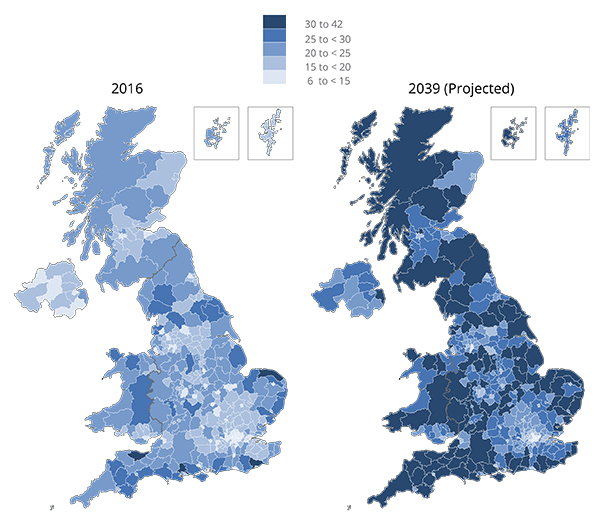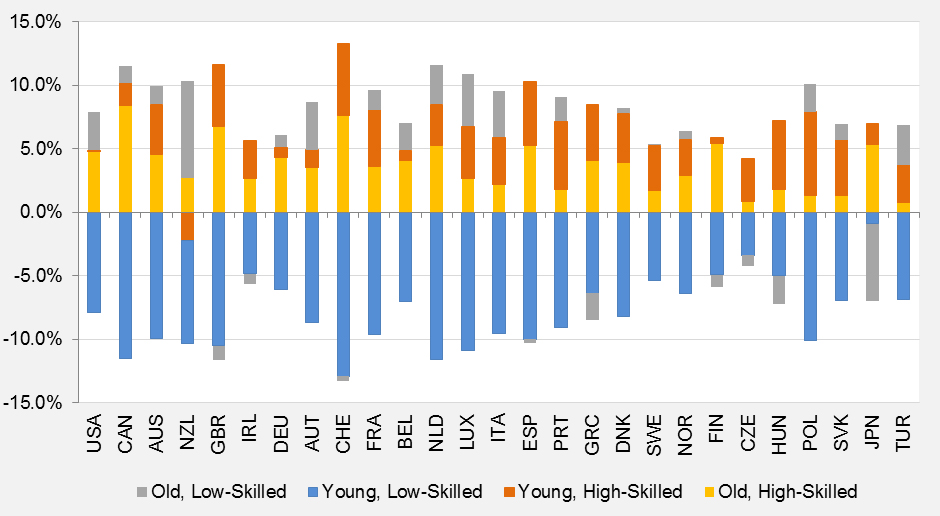A recent article from the UK’s Office of National Statistics contains an eye-catching map: it contrasts the proportion of the population aged 65 years and over in 2016 to its projected value in 2039, across the UK’s local authorities. The darker the shade of blue, the greater the concentration of those aged 65 years and over. The map depicting the projected structure of the population in 2039 looks like a deep-dyed version of the map for 2016.
Figure 1: Proportion of the population aged 65 years and over, 2016 and 2039, UK

Source: ONS (2018). Figure 3 in “Living longer: how our population is changing and why it matters”
Such demographic changes are not unique to the UK, but rather a global phenomenon. Alongside ageing, two other phenomena are shaping the composition of the population and that of the workforce in OECD countries: improvements in educational attainment and migration – both immigration and emigration.
Ageing has long evoked concerns in policy circles, whereas improvements in educational attainment are seen as a means to increase access to better labour market opportunities. At the same time, immigration has often been blamed for negatively affecting the labour market outcomes of the least educated. Economists have looked at the economic implications of each of these three phenomena. However, we still do not have evidence about how the implications of each of these labour-supply phenomena for different groups of the population compare to one another, and what their combined effects might be.
How changes in the composition of the workforce are affecting wages
In a recent study published in the European Economic Review (Docquier et al., 2019), we draw on a rich database to explore the impact on wages due to migration and the changes in the education and the age structure of the population between 2000 and 2010 in a number of OECD countries. Unlike previous studies, we compare the impact of each of these labour-supply changes, as well as their combined effects, on different groups of the population
Initial observations from the data suggest that between 2000 and 2010, there was a stark decline in the share of young low-skilled workers across all countries among the native-born. Simultaneously, there was an increase in the share of high skilled workers, both young and old, across almost all countries too. This is because people are getting older, younger generations are more educated than previous ones, and some people up-skill as they get older. In most countries, there has been an increase in the share of older low-skilled workers. Also, the changes in the age-education structure among migrants are generally similar to those of the native-born. However, migrants remain much younger than the native-born.
Figure 2. Changes in population shares by age-education group (in percentage points), 2000- 2010

The figure illustrates the changes in the share if each education-age group amongst the native-born between 2000-2010. Data cover those of age 25-65. Young refers to those of age 25-44 and old refers to those of age 45-65.
The key question we ask is: what would have happened to the wages of the different native-born workers if the only things that changed in the labour market between 2000 and 2010 were the reductions or increases in shares of particular groups in the workforce?
The analysis shows that the change in the age and skill structure of the workforce is the key influencer of wages, with changes in the education level of the workforce playing a dominant role. Immigration plays a relatively small role and even has a positive effect for some groups.
The group that experiences the largest positive impact from demographic and education changes are young low-skilled workers. The older high-skilled workers suffer a large negative impact. This is consistent with what one would expect: economics tells us that, all things being equal, if something becomes scarcer on the market, its price increases. Therefore, groups of workers that have experienced the greatest relative decline in their share of the workforce stand to gain from increases in their wages. In summary, three broad sets of results emerge:
- In most of Western Europe, Japan and the United States, ageing and changes in education levels account for most of the changes in wages. Migration plays a marginal role.
- In some countries which have relatively liberal and skill-biased migration policies (Australia, Canada, New Zealand, the UK and Switzerland), immigration accentuates the equalising impact of ageing on wages.
- The impact of ageing is partially offset by emigration in countries which have seen significant labour outflows – e.g. Ireland and certain Eastern/Central European countries.
Relaxing some of the assumptions of the model
These results rely on the assumption that technological changes over the last years affected all groups in the workforce uniformly. Earlier studies suggest that this is not the case, and that technological changes have rather been more beneficial to high-skilled workers (Acemoglu and Autor, 2011). We therefore adjust our model to account for this fact. Doing so offsets the wage gains initially predicted by the model for low-skilled workers. This reconciles our findings with the observed increases in the skill premium in many countries in recent years (Autor, Katz and Kearney, 2008). The results are, however, robust to other multiple changes.
What this says
To put it differently, in the absence of technological changes that is more favourable to high-skilled workers, young low-skilled workers would have benefited the most from the three labour-supply phenomena. With more technological changes on the horizon, a more urgent egalitarian policy debate might be on how to deal with technological changes that are unfavourable to particular workers. Immigration may end up being a plausible scapegoat in the short run only.
Citation
Docquier, F., Kone. Z., Mattoo, A. & Ozden, C. (2019) Labor market effects of demographic shifts and migration in OECD countries, European Economic Review, Volume 113, April 2019, Pages 297-324; https://doi.org/10.1016/j.euroecorev.2018.11.007

